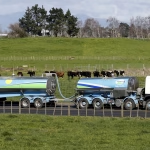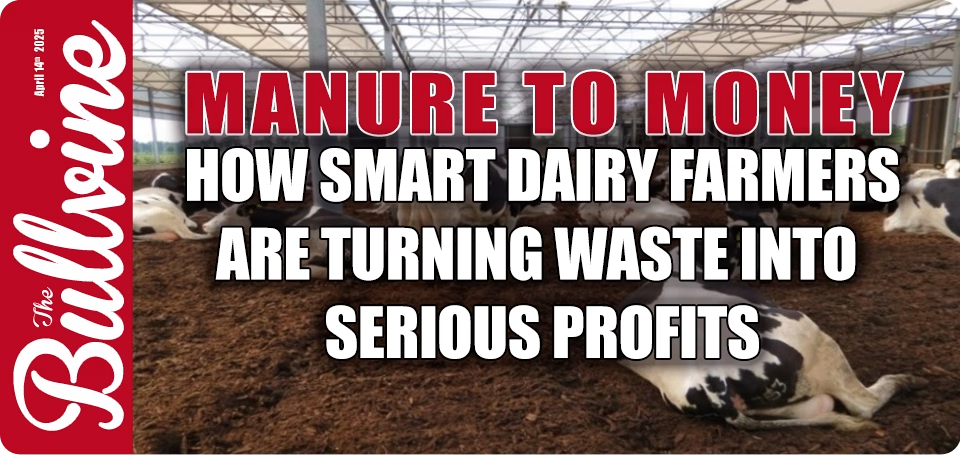Latest News
Dairy Trade Crisis: U.S. Exports Face 125% China Tariffs Amid “Difficult Trifecta” of Challenges
U.S. Dairy Under Siege: 125% China Tariffs, Bird Flu & Labor Crunch Threaten $76B Industry's Survival. EXECUTIVE SUMMARY: The U.S. dairy industry faces a pe […]Fonterra’s Fixed Milk Price Hits Record $9.60 as Farmers Rush to Lock in Future Income
Fonterra's FMP hits $9.60 as 500+ farmers lock in 2026 prices amid global volatility. Why this risk move matters. EXECUTIVE SUMMARY: Fonterra’s April Fixed Milk […]FMD JUMPS CONTAINMENT LINES: New Hungarian Outbreak Signals Dangerous Phase for Dairy Industry
FMD outbreak leaps containment in Hungary, threatening EU dairy trade. 30km viral jump stuns experts—what it means for your farm. EXECUTIVE SUMMARY: Hungary's f […]Dairy Market Weekly: April 20, 2025 – Cull Cow Price Surge, Synthetic Whey Lawsuit, and Futures Rally Amid Seasonal Pressures
Cull cow prices soar, synthetic whey faces legal battles , and spring flush meets Easter weekend in a perfect storm for dairy markets! EXECUTIVE SUMMARY: The U. […]Milk-Based Protein Drinks: The Recovery Edge Your Dairy Operation Should Be Marketing
Milk-based protein drinks boost recovery 40% better than water! Dairy farmers: cash in on this $47B market goldmine. EXECUTIVE SUMMARY: Milk outperforms water a […]
More News
- Fine-Tuning Haylage and Cereal Silage Quality for Different Life Stages Within the Dairy Herd
- CME Dairy Market Report: April 17, 2025 – Cheese Blocks Rally as Barrels Retreat
- Beyond Blocks and Blades: Why Your Lameness Treatment Protocol Is Missing a Critical Component
- March Milk Meltdown: The Hard Truth About FMMO Price Declines
- CME Dairy Market Report: April 16, 2025 – Cheddar Blocks Surge While Barrels Reverse Course; Butter Continues Decline Amid Stable Powder Markets
- Double-Ovsynch or Double E-Synch? Which Fertility Program Will Boost Your Herd’s Pregnancy Rates?
- AI Eyes on Your Herd: Why Automated Lameness Detection Is Revolutionizing Dairy Farming
- The Impact of Tariffs on Global Dairy Demand: A Sector Under Pressure
- Protein Power Play: How Dairy Can Dominate The GLP-1 Revolution
- Dairy Profit Squeeze 2025: Why Your Margins Are About to Collapse (And What to Do About It)
Top News Posts from Past Week
- Double-Ovsynch or Double E-Synch? Which Fertility Program Will Boost Your Herd’s Pregnancy Rates?
- Dairy’s Golden Calf Rush: $1,000+ Crossbreds Reshape Farm Economics
- The $1,000 Calves & $4,000 Springers: How Long Will This Gravy Train Keep Rolling?
- Dairy Titans Unite: Arla-DMK Merger Reshapes Europe’s Dairy Landscape
- Mega-Dairy Revolution: Inside the World’s 10 Largest Dairy Farms
- Farmers Stand In Silence At Auction So A Young Man Can Buy Back His Family Farmhouse
- AI Eyes on Your Herd: Why Automated Lameness Detection Is Revolutionizing Dairy Farming
- March Milk Meltdown: The Hard Truth About FMMO Price Declines
- FMD JUMPS CONTAINMENT LINES: New Hungarian Outbreak Signals Dangerous Phase for Dairy Industry
- 84% TARIFF SHOCK: How the US-China Trade War Will Reshape Your Dairy Business
Feature Articles
Expo-Printemps 2025 – Ayrshire
April 18th, 2025 @ Victoriaville QC Winter Calf Née entre le 1er décembre 2024 et le 28 février 2025 BRIXHAM RINGER LUST, AYCANF14729455Propriété-élevéeWINDARRA […]Expo-Printemps 2025 – Jersey
April 18th, 2025 @ Victoriaville QC JOLICHUTES VICTORIOUS BERLINGOT Grand Champion Quebec Spring Jersey Show 2025 JOHNY JACOBS, JAYDEN DOIRON & BRENT SAYLES, QC […] Expo-Printemps 2025 – HolsteinApril 17th, 2025 @ Victoriaville QC Grand Champion PIERSTEIN DEVOUR ROSHA Grand Champion Quebec Spring Holstein Show 2025 PIERRE BOULET, MONTMAGNY, QC Grand - P […]
Expo-Printemps 2025 – HolsteinApril 17th, 2025 @ Victoriaville QC Grand Champion PIERSTEIN DEVOUR ROSHA Grand Champion Quebec Spring Holstein Show 2025 PIERRE BOULET, MONTMAGNY, QC Grand - P […] Expo-Printemps 2025 – Red & White HolsteinApril 17th, 2025 @ Victoriaville QC STONEHAVEN BELIEVE JASPER Grand Champion Quebec Spring Red & White Holstein Show 2025 CEDARHOLME HOLSTEINS, PAUL HARRIS, MOU […]
Expo-Printemps 2025 – Red & White HolsteinApril 17th, 2025 @ Victoriaville QC STONEHAVEN BELIEVE JASPER Grand Champion Quebec Spring Red & White Holstein Show 2025 CEDARHOLME HOLSTEINS, PAUL HARRIS, MOU […] Hearts of the Heartland: Young Dairy Farm Girls’ Extraordinary Battles for LifeYoung dairy farm girls Lexi, Reese & Sydni defy death through transplants, fire recovery & paralysis—proving resilience rooted in rural communities and […]
Hearts of the Heartland: Young Dairy Farm Girls’ Extraordinary Battles for LifeYoung dairy farm girls Lexi, Reese & Sydni defy death through transplants, fire recovery & paralysis—proving resilience rooted in rural communities and […]
More Articles
- 5 Powerful Stress-Busting Techniques Every Dairy Farmer Needs This Spring
- Mystic Valley Dairy: The Secret Behind Their Jaw-Dropping 125-Pound ECM Average
- MANURE TO MONEY: How Smart Dairy Farmers Are Turning Waste into Serious Profits
- Hanoverhill Starbuck’s DNA Dynasty: The Holstein Legend Bridging 20th-Century Breeding to Genomic Futures
- Revolutionary Colostrum Protocol Adding $500 Per Heifer to Your Bottom Line
- 2024 Holstein Canada Master Breeders: Excellence in Balance, Breeding, and Legacy
- Dad at 80: How Murray Hunt Revolutionized Canadian Dairy Genetics
- When Faith Meets Farming: Mark Yeazel’s Amazing Journey from Holstein Breeder to Tanzanian Dairy Missionary
- BLACK HIDE BLINDNESS: Why Breeding Only for Color is Destroying Your Dairy-Beef Profits
- Stud Wars: April 2025 – The Genetic Force Awakens
Top Feature Articles from the Past Month
- Expo-Printemps 2025 – Holstein
- Top 15 Best Milk Brands in the USA: Unveiling the Cream of the Crop
- Northeast Spring National Holstein Show 2025
- Hanoverhill Starbuck’s DNA Dynasty: The Holstein Legend Bridging 20th-Century Breeding to Genomic Futures
- The Cow That Built an Empire: Comestar Laurie Sheik’s Unstoppable Genetic Legacy
- 10 Sires To Breed The Next World Dairy Expo Grand Champion
- Why Donald Trump Hates Canada’s Dairy Supply System
- CAPTAIN: The Bull That Rewrote the Rules for Modern Breeding
- Making Dreams Come True: The Journey of Tom & Kelli Cull
- The $4,300 Gamble That Reshaped Global Dairy Industry: The Pawnee Farm Arlinda Chief Story
- Expo-Printemps 2025 - Ayrshire
-
Expo-Printemps 2025 – Ayrshire
Andrew Hunt Apr 20, 2025April 18th, 2025 @ Victoriaville QC Winter Calf Née entre le 1er décembre 2024 et le 28 février 2025 BRIXHAM RINGER LUST, AYCANF14729455Propriété-élevéeWINDARRA FARMS, UPPER RAWDON, NS DES ERABLES SAIGON MARIELLA, AYCANF122013176TY-D HOLSTEINS, SAINT-BASILE, QC BAVAROISE STA… Read More - Expo-Printemps 2025 - Jersey
-
Expo-Printemps 2025 – Jersey
Andrew Hunt Apr 20, 2025April 18th, 2025 @ Victoriaville QC JOLICHUTES VICTORIOUS BERLINGOT Grand Champion Quebec Spring Jersey Show 2025 JOHNY JACOBS, JAYDEN DOIRON & BRENT SAYLES, QC JOLICHUTES VICTORIOUS BERLINGOT Intermediate Champion Quebec Spring Jersey Show 2025 JOHNY JACOBS, JAYDEN DOIRON & BRENT S… Read More
- Expo-Printemps 2025 - Holstein
-
Expo-Printemps 2025 – Holstein
Andrew Hunt Apr 17, 2025April 17th, 2025 @ Victoriaville QC Grand Champion PIERSTEIN DEVOUR ROSHA Grand Champion Quebec Spring Holstein Show 2025 PIERRE BOULET, MONTMAGNY, QC Grand - PIERSTEIN DEVOUR ROSHA - PIERRE BOULET, MONTMAGNY, QCReserve - JACOBS UNIX CARFUL - FERME JACOBS INC, … Read More
- Expo-Printemps 2025 - Red & White Holstein
-
Expo-Printemps 2025 – Red & White Holstein
Andrew Hunt Apr 17, 2025April 17th, 2025 @ Victoriaville QC STONEHAVEN BELIEVE JASPER Grand Champion Quebec Spring Red & White Holstein Show 2025 CEDARHOLME HOLSTEINS, PAUL HARRIS, MOUNT FOREST, ON GOLDEN-OAKS-I ALTITUDE IREINE Junior Champion Quebec Spring Red & White Holstein Show 2025 BILL MAYO, EDMOND P… Read More
- Hearts of the Heartland: Young Dairy Farm Girls' Extraordinary Battles for Life
-
Hearts of the Heartland: Young Dairy Farm Girls’ E…
Andrew Hunt Apr 16, 2025Young dairy farm girls Lexi, Reese & Sydni defy death through transplants, fire recovery & paralysis—proving resilience rooted in rural communities and dairy cattle bonds. E237 Hearts of the Heartland: Young Dairy Farm Gir | RSS.com When discussing strength in the dairy industry, the… Read More
- 5 Powerful Stress-Busting Techniques Every Dairy Farmer Needs This Spring
-
5 Powerful Stress-Busting Techniques Every Dairy F…
Andrew Hunt Apr 16, 2025Beat spring burnout! 5 science-backed strategies dairy farmers use to survive calving season and thrive. Mental health = farm health. E236 5 Powerful Stress-Busting Techniques Every Da | RSS.com Spring brings more than just new growth to your dairy operation—it delivers a perfect storm of str… Read More
- Mystic Valley Dairy: The Secret Behind Their Jaw-Dropping 125-Pound ECM Average
-
Mystic Valley Dairy: The Secret Behind Their Jaw-D…
Karen Hunt Apr 15, 2025Wisconsin's Mystic Valley Dairy shatters records with 125 pounds of energy-corrected milk daily. Discover how "doing 100 little things right" creates extraordinary results. E235 Mystic Valley Dairy: The Secret Behind Their | RSS.com Ever wonder what it takes to run a dairy farm where cows pr… Read More
- MANURE TO MONEY: How Smart Dairy Farmers Are Turning Waste into Serious Profits
-
MANURE TO MONEY: How Smart Dairy Farmers Are Turni…
Andrew Hunt Apr 14, 2025Dairy farmers are flushing away $15,000 per 100 cows annually. Discover how savvy producers are turning manure into a goldmine through strategic composting. E234 MANURE TO MONEY: How Smart Dairy Farmers Are | RSS.com While your neighbors complain about your farm's smell and regulators circle… Read More
- Hanoverhill Starbuck's DNA Dynasty: The Holstein Legend Bridging 20th-Century Breeding to Genomic Futures
-
Hanoverhill Starbuck’s DNA Dynasty: The Holstein L…
Andrew Hunt Apr 12, 2025From $2,500 calf to genetic revolution: How one bull's DNA reshaped global dairy farming and still whispers in 83% of Holsteins today. E233 Hanoverhill Starbuck’s DNA Dynasty: The Holst | RSS.com The legendary Hanoverhill Starbuck, pictured here at 5 years old by photographer Jim Rose, stands… Read More
- Revolutionary Colostrum Protocol Adding $500 Per Heifer to Your Bottom Line
-
Revolutionary Colostrum Protocol Adding $500 Per H…
Andrew Hunt Apr 11, 2025Are you discarding liquid gold? Discover how extended colostrum feeding adds $500 per heifer while slashing treatment costs and boosting lifetime milk. E232 Revolutionary Colostrum Protocol Adding $500 | RSS.com Your current calf feeding program may be limiting your profitability by up to $5… Read More
Tanbark Trail
Expo-Printemps 2025 – Ayrshire
April 18th, 2025 @ Victoriaville QC Winter Calf Née entre le 1er décembre 2024 et le 28 février 2025 BRIXHAM RINGER LUST, AYCANF14729455Propriété-élevéeWINDARRA FARMS, UPPER RAWDON, NS DES ERABLES SAIGON MARIELLA, AYCANF122013176TY-D HOLSTEINS, SAINT […]Expo-Printemps 2025 – Jersey
April 18th, 2025 @ Victoriaville QC JOLICHUTES VICTORIOUS BERLINGOT Grand Champion Quebec Spring Jersey Show 2025 JOHNY JACOBS, JAYDEN DOIRON & BRENT SAYLES, QC JOLICHUTES VICTORIOUS BERLINGOT Intermediate Champion Quebec Spring Jersey Show 2025 JOHN […] Expo-Printemps 2025 – HolsteinApril 17th, 2025 @ Victoriaville QC Grand Champion PIERSTEIN DEVOUR ROSHA Grand Champion Quebec Spring Holstein Show 2025 PIERRE BOULET, MONTMAGNY, QC Grand - PIERSTEIN DEVOUR ROSHA - PIERRE BOULET, MONTMAGNY, QCReserve - JACOBS UNIX CARFUL -&nb […]
Expo-Printemps 2025 – HolsteinApril 17th, 2025 @ Victoriaville QC Grand Champion PIERSTEIN DEVOUR ROSHA Grand Champion Quebec Spring Holstein Show 2025 PIERRE BOULET, MONTMAGNY, QC Grand - PIERSTEIN DEVOUR ROSHA - PIERRE BOULET, MONTMAGNY, QCReserve - JACOBS UNIX CARFUL -&nb […] Expo-Printemps 2025 – Red & White HolsteinApril 17th, 2025 @ Victoriaville QC STONEHAVEN BELIEVE JASPER Grand Champion Quebec Spring Red & White Holstein Show 2025 CEDARHOLME HOLSTEINS, PAUL HARRIS, MOUNT FOREST, ON GOLDEN-OAKS-I ALTITUDE IREINE Junior Champion Quebec Spring Red & White Hols […]
Expo-Printemps 2025 – Red & White HolsteinApril 17th, 2025 @ Victoriaville QC STONEHAVEN BELIEVE JASPER Grand Champion Quebec Spring Red & White Holstein Show 2025 CEDARHOLME HOLSTEINS, PAUL HARRIS, MOUNT FOREST, ON GOLDEN-OAKS-I ALTITUDE IREINE Junior Champion Quebec Spring Red & White Hols […]Northeast Spring National Holstein Show 2025
March 31st, 2025 @ Hamburg, NY E217 Northeast Spring National Holstein Show 2025 | RSS.com The New York Spring Holstein Show, judged by Ryan Krohlow, showcased exceptional dairy cattle across multiple age divisions. The competition featured remarkabl […]
The Bullvine LLC © 2025 | Terms of Use | Community Guidelines | Privacy Policy |
Manage Consent
To provide the best experiences, we use technologies like cookies to store and/or access device information. Consenting to these technologies will allow us to process data such as browsing behavior or unique IDs on this site. Not consenting or withdrawing consent, may adversely affect certain features and functions.
Functional Always active
The technical storage or access is strictly necessary for the legitimate purpose of enabling the use of a specific service explicitly requested by the subscriber or user, or for the sole purpose of carrying out the transmission of a communication over an electronic communications network.
Preferences
The technical storage or access is necessary for the legitimate purpose of storing preferences that are not requested by the subscriber or user.
Statistics
The technical storage or access that is used exclusively for statistical purposes.
The technical storage or access that is used exclusively for anonymous statistical purposes. Without a subpoena, voluntary compliance on the part of your Internet Service Provider, or additional records from a third party, information stored or retrieved for this purpose alone cannot usually be used to identify you.
Marketing
The technical storage or access is required to create user profiles to send advertising, or to track the user on a website or across several websites for similar marketing purposes.
























